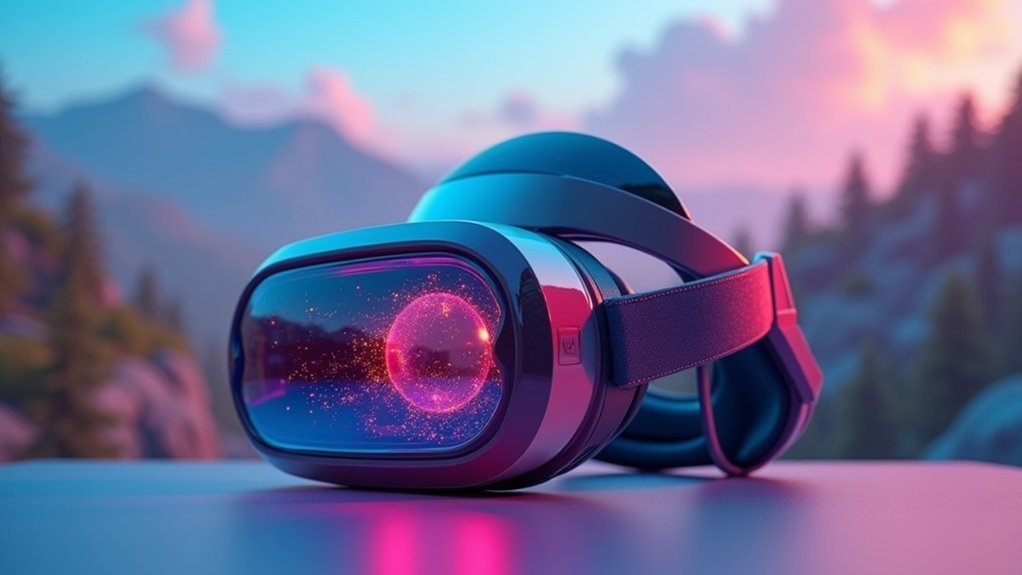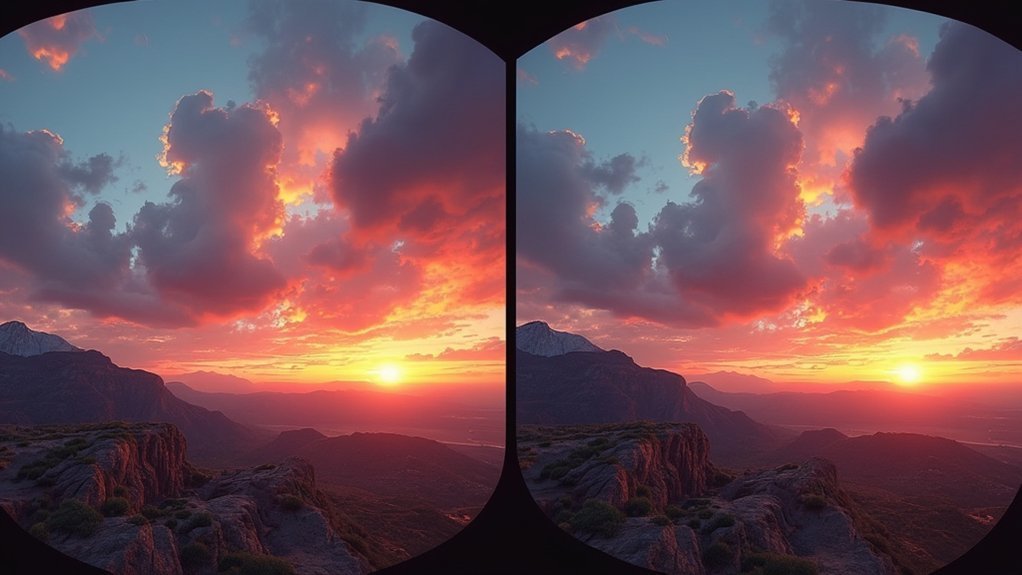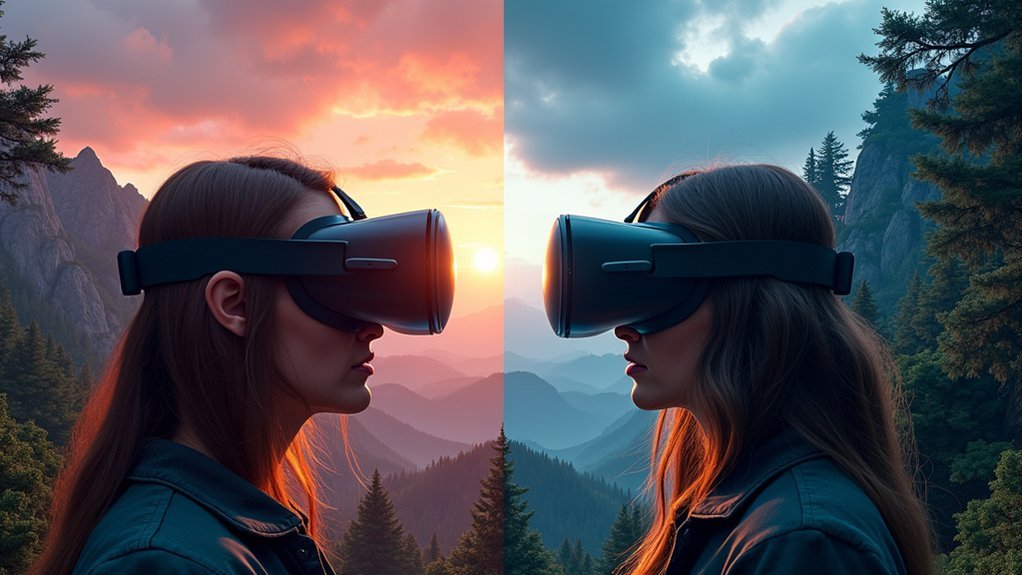VR field of view orientations differ in how they measure your visual range: Horizontal FOV (HFOV) captures your left-to-right vision typically ranging 90-210 degrees, while Vertical FOV (VFOV) measures up-and-down visibility usually limited to 40-110 degrees with restricted upward vision. Diagonal FOV (DFOV) measures corner-to-corner across the display for extensive visual range. Each orientation affects immersion differently—wider HFOV reduces tunnel vision, adequate VFOV prevents motion sickness, and broader DFOV enhances overall comfort. Understanding these distinctions will help you optimize your virtual experiences.
Understanding VR Field of View Fundamentals

When you put on a VR headset, the field of view determines how much of the virtual world you can see without moving your head. FOV typically ranges from 90 to 110 degrees in standard headsets, while premium models exceed 120 degrees.
VR headset field of view ranges from 90-110 degrees in standard models, with premium versions exceeding 120 degrees for enhanced immersion.
You’ll encounter three key measurements: horizontal FOV (HFOV) covers your left-to-right vision, vertical FOV (VFOV) spans top-to-bottom viewing, and diagonal FOV (DFOV) represents the overall viewing capability that manufacturers primarily use for specifications.
Your Field of Vision directly impacts immersion quality. Wider FOV creates more natural peripheral vision, making virtual environments feel realistic.
However, hardware constraints like optics and display technology limit achievable angles. Additionally, your facial structure and headset fit affect perceived FOV, which is why adjustable settings matter for ideal experiences.
Horizontal FOV in Virtual Reality Systems
Although vertical FOV contributes to immersion, horizontal Field of View (HFOV) serves as the primary driver of your sense of presence in virtual environments.
HFOV measures the visible environment angle from left to right through your VR headset, typically expressed in degrees. High-end models offer HFOVs up to 210 degrees, creating a more immersive experience by allowing you to perceive more virtual space simultaneously.
A wider HFOV reduces feelings of confinement while improving overall engagement. It’s essential for simulating natural human peripheral vision, which spans approximately 180 degrees, enhancing realism notably.
When comparing VR systems, manufacturers specify HFOV as a key feature, enabling you to evaluate different headsets’ immersive capabilities effectively before making purchasing decisions.
Vertical FOV in Virtual Reality Systems

When you’re experiencing VR, your vertical field of view determines how much you can see above and below your natural sight line, but it’s often more restricted than your horizontal range.
You’ll notice that most headsets limit your upward vision to around 10 degrees and downward to about 40 degrees, creating a natural viewing window that mimics real-world eye movement patterns.
These height angle constraints directly impact where developers can place UI elements and interactive objects without forcing you to crane your neck uncomfortably.
Vertical Range Limitations
While horizontal field of view often receives the most attention in VR discussions, vertical FOV limitations present equally critical challenges that directly impact your immersion and comfort.
Current VR systems restrict your Vertical Field of View (VFOV) to ranges between 40 and 110 degrees, creating noticeable boundaries that can break immersion when you look up or down.
These limitations force developers to position content within specific zones—typically 40 degrees below and 10 degrees above your eye level—to guarantee visibility.
When VFOV is too restricted, you’ll experience motion sickness as your brain struggles to reconcile the limited vertical perspective with natural head movements.
This constraint requires careful UI placement and environmental design, as content outside these boundaries becomes inaccessible without uncomfortable neck positioning.
Height Angle Impact
The specific height angles within your vertical field of view create distinct zones that dramatically affect how you perceive and interact with virtual content. Your ideal viewing zone spans 40 degrees downward from the horizon line and 10 degrees upward, forming the sweet spot for comfortable interaction. Content placed within this range feels naturally accessible and immersive.
When developers position elements outside these angles, you’ll strain your neck looking up or down, disrupting your experience.
Your vertical field of view (VFOV) determines how much vertical space you can see without head movement. Limited VFOV restricts your spatial awareness and reduces immersion quality. Higher-end headsets expand these angles to create more natural viewing zones, accommodating your natural posture while maintaining visual clarity across the entire vertical spectrum.
Diagonal FOV Measurements and Applications
You’ll find diagonal FOV offers the most thorough measurement of your VR headset’s visual range, capturing the widest extent from corner to corner of the display.
Technical standards for DFOV typically involve measuring the angular span across the diagonal plane, which manufacturers like Pimax use to advertise impressive 150-210 degree specifications.
This measurement proves especially valuable because it directly correlates with your sense of immersion and peripheral awareness in virtual environments.
Diagonal FOV Definition
When measuring a VR headset’s field of view, diagonal FOV (DFOV) captures the angle of view across the display’s diagonal, giving you the most complete picture of the headset’s visual capacity. Unlike horizontal or vertical measurements that only assess specific dimensions, diagonal FOV encompasses your full visual range, making virtual environments feel more immersive and realistic.
| VR Headset | Diagonal FOV |
|---|---|
| Pimax 8KX | 200° |
| Varjo Aero | 115° |
| Meta Quest 3 | 110° |
| Pico 4 | 105° |
| HTC Vive Pro 2 | 120° |
DFOV directly influences your comfort and engagement levels. Wider diagonal measurements reduce feelings of confinement and enhance your overall experience. That’s why manufacturers like Pimax prominently advertise their expansive DFOV specifications, understanding that this measurement reflects the largest viewing angle you’ll experience.
Measurement Technical Standards
Although industry standards for diagonal FOV measurements remain inconsistent across VR manufacturers, understanding these technical specifications becomes critical when you’re evaluating headset performance.
Different companies use varying measurement methodologies, making direct comparisons challenging. Some manufacturers measure diagonal FOV at the lens center, while others calculate maximum theoretical angles that may not reflect real-world usage.
You’ll encounter diagonal FOV specifications ranging from 90 degrees in entry-level devices to over 210 degrees in premium headsets. However, these numbers don’t always translate directly to perceived immersion.
FOV settings in software can also affect your actual viewing experience, as developers optimize content for specific diagonal FOV ranges. When comparing headsets, look for standardized testing conditions and consider trying devices personally to gauge true immersive capabilities.
Practical Usage Benefits
Beyond the technical specifications lies the real-world impact these diagonal FOV measurements have on your VR experience. When you’re selecting a VR headset, diagonal Field of View (FOV) directly affects how immersed you’ll feel in virtual environments. Higher diagonal FOVs reduce tunnel vision and create more natural peripheral awareness.
| FOV Range | Visual Experience | Best Applications |
|---|---|---|
| 90-110° | Limited immersion | Basic simulations |
| 110-150° | Standard comfort | Gaming, training |
| 150-210° | Maximum presence | Flight sims, exploration |
You’ll notice content placement becomes essential as FOV increases. Developers must position UI elements within your comfortable viewing range, preventing neck strain. The expansive vision from maximized diagonal FOV closely mimics your natural peripheral vision, eliminating claustrophobic feelings that narrow fields create during extended sessions.
How FOV Orientations Affect Immersion Levels
Field of view orientations in VR directly shape how immersed you’ll feel in virtual worlds, with horizontal FOV (HFOV) playing the most significant role in creating that sense of presence.
When you experience wider HFOVs reaching up to 210 degrees, you’ll feel more enveloped in the virtual environment as it mimics your natural peripheral vision. This enhanced Field of View (FOV) reduces feelings of confinement while boosting your engagement levels.
Wider HFOVs up to 210 degrees eliminate confinement feelings by matching natural peripheral vision, dramatically boosting virtual engagement levels.
Vertical FOV (VFOV) complements this by enabling natural up-and-down viewing, vital for exploring landscapes or traversing vertical spaces.
Together, HFOV and VFOV create the diagonal field of view, delivering holistic immersion. Studies confirm you need FOVs above 100 degrees to prevent discomfort and maintain that essential feeling of presence in virtual environments.
Comparing Horizontal Vs Vertical FOV Impact

When you’re evaluating VR performance, horizontal and vertical FOV create distinctly different impacts on your overall experience.
Your Horizontal Field of View (HFOV) primarily affects peripheral awareness and presence, reducing tunnel vision when refined between 90-210 degrees. You’ll notice enhanced immersion and spatial understanding as HFOV increases, making virtual environments feel more natural and encompassing.
Your Vertical Field of View (VFOV), typically ranging 30-90 degrees, influences your ability to perceive objects above and below your direct line of sight. While VFOV restrictions may seem less noticeable initially, they considerably impact applications requiring upward or downward viewing.
Limited VFOV can cause discomfort and restrict functionality in architectural visualizations or games with vertical elements. Balancing both orientations guarantees ideal spatial awareness and prevents the claustrophobic sensation that narrow FOVs often create.
Technical Specifications Across VR Headsets
You’ll find significant variation in FOV capabilities when comparing technical specifications across different VR headsets, with some models offering adjustable settings while others maintain fixed parameters.
Your headset’s resolution directly impacts how effectively you’ll perceive the available field of view, as higher pixel density creates sharper images that maximize the immersive potential of wider viewing angles.
Understanding these hardware limitations and resolution relationships helps you make informed decisions about which headset specifications align with your VR experience goals.
Hardware FOV Capabilities
Since VR headsets measure field of view through three distinct angles—horizontal FOV (HFOV), vertical FOV (VFOV), and diagonal FOV (DFOV)—understanding these specifications helps you choose the right headset for your needs.
The Oculus Quest 2 delivers 89 degrees HFOV and 93 degrees VFOV, making it adequate for casual FOV in virtual experiences alongside decent video resolution. However, the Valve Index’s 130-degree HFOV greatly reduces tunnel vision effects.
For maximum immersion, the Pimax 8K reaches up to 210 degrees DFOV, compared to standard models offering 90-110 degrees DFOV.
You’ll find that ideal lens distance adjustments can affect your perceived field of view, meaning individual experiences may vary even with identical hardware specifications across different users.
Resolution Impact Analysis
While field of view measurements provide the foundation for VR immersion, resolution specifications directly determine how sharp and clear your virtual experience appears within that viewing angle.
Your VR resolution directly impacts how you perceive FOV quality – higher resolutions like 6K and 8K reduce the screen door effect that can break immersion within your headset’s viewing window.
When you’re watching stereoscopic content, resolutions effectively double in height, with 4K stereoscopic reaching 3840 x 3840 pixels. This enhancement dramatically improves depth perception within your FOV boundaries.
However, achieving true 4K clarity requires much higher source resolutions – you’ll need 12K to 16K content for genuine 4K viewing experiences that fully utilize your headset’s FOV capabilities without pixelation or clarity loss.
User Experience Differences by FOV Orientation
When you experience VR content with different FOV orientations, the impact on your comfort and immersion becomes immediately apparent. A wider horizontal Field of View (FOV) dramatically enhances your sense of presence by expanding your Peripheral Vision, making virtual environments feel more natural and engaging.
You’ll notice reduced feelings of confinement as more of the virtual world becomes visible horizontally.
Vertical FOV orientation directly affects your comfort levels. When VFOV is properly calibrated to around 40 degrees downward and 10 degrees upward, you’ll experience smoother interactions without awkward head movements.
Limited vertical viewing ranges force uncomfortable neck positioning, potentially triggering motion sickness. You’ll find that balanced FOV orientations create the most enjoyable experiences, while excessive horizontal expansion or poor vertical calibration detracts from realism and overall satisfaction.
Hardware Limitations and FOV Orientation Trade-offs
Although VR headset manufacturers aim for maximum immersion, you’ll quickly discover that hardware limitations force critical compromises between FOV expansion and performance quality.
Advanced optics enable wider viewing angles, but you’ll face increased processing demands that can strain your system’s capabilities. Display technology quality directly impacts how effectively manufacturers can implement wider FOVs without introducing distortion.
Advanced VR optics create wider viewing angles but demand significantly more processing power, potentially overwhelming your system’s performance capabilities.
You’ll notice that lens distance and placement require careful calibration—pushing FOV boundaries often means sacrificing viewing comfort.
Pimax headsets demonstrate this trade-off, offering impressive diagonal FOV measurements while demanding high-end hardware for peak performance. Your facial structure and interpupillary distance further complicate matters, as manufacturers must balance universal design with individual user differences.
Ultimately, you’re experiencing the delicate balance between technological ambition and practical implementation constraints.
Optimal FOV Settings for Different VR Applications
Because different VR applications demand distinct visual approaches, you’ll need to adjust FOV settings based on your specific use case rather than defaulting to maximum width.
Here’s how to optimize FOV for different virtual reality (VR) experiences:
- Gaming applications – Use wider FOV up to 210 degrees for maximum immersion and competitive advantage.
- Simulation and training – Set moderate FOV around 110 degrees to balance realism with comfort and prevent motion sickness.
- Social VR experiences – Choose narrower FOV between 90-110 degrees to facilitate interaction while maintaining presence.
- Design and medical simulations – Optimize FOV at 100-110 degrees for visual clarity and reduced eye strain.
- Custom applications – Gather user feedback to fine-tune FOV settings for maximum comfort and engagement.
Tailoring your FOV configuration improves user experience considerably across all virtual reality applications.
Content Design Considerations for FOV Orientations
Since horizontal field of view (HFOV) drives immersion more than vertical perspectives, you’ll need to design content that leverages this natural panoramic vision while respecting the limitations of your chosen FOV orientation.
Design content that embraces our natural panoramic vision while working within your chosen field of view constraints.
When developing content design considerations, position critical elements within the central visible area to minimize excessive head movement. Keep important interactions within a 30-degree rotation range for best accessibility.
Place vertical content around the horizon line, targeting a 40-degree downward and 10-degree upward angle for maximum comfort.
For narrow FOVs, establish clear visual hierarchy by avoiding peripheral placement of interactive elements. This prevents user frustration and maintains engagement.
Always conduct user testing to evaluate how your FOV orientation affects comfort and immersion, allowing you to refine content positioning based on real feedback about usability and visual accessibility.
Measuring and Testing FOV Orientations
When you’re ready to evaluate your VR experience’s effectiveness, measuring FOV orientations requires both technical precision and user-centered testing approaches.
You’ll need specialized equipment or software to assess the visible area within your headset when looking straight ahead. Testing involves measuring horizontal, vertical, and diagonal FOV, with diagonal being most important for immersion evaluation.
Key methods for measuring and testing FOV orientations include:
- Using specialized equipment or software to assess visible areas within the headset
- Gathering user feedback on comfort and immersion levels during gameplay
- Adjusting headset settings based on individual interpupillary distance and head size
- Evaluating participants’ experiences across varying FOV settings
- Measuring standard ranges between 90-110 degrees HFOV up to 210 degrees
Choosing the Right FOV Orientation for Your Needs
After completing your FOV measurements and testing, you’ll need to match your specific requirements with the ideal orientation configuration.
For gaming applications, prioritize wider HFOV settings between 90-210 degrees to maximize peripheral vision and spatial awareness during competitive play. You’ll achieve better immersion at optimal distance when your headset supports these broader horizontal ranges.
If you’re focusing on detailed work or precision tasks, emphasize VFOV enhancement instead. AR applications typically require 30-50 degrees vertically, while immersive VR experiences benefit from higher vertical values for enhanced comfort and engagement.
Consider DFOV as your extensive measurement combining both orientations. This gives you the complete picture of your observable virtual environment, ensuring your chosen FOV orientation delivers maximum effectiveness for your specific use case and hardware capabilities.
Frequently Asked Questions
What Is the Best Fov for VR?
You’ll find the best VR FOV ranges between 90-120 degrees for comfort, though you’d prefer around 210 degrees for maximum immersion that mimics natural human vision and reduces motion sickness.
What Is the Difference Between 60 Fov and 90 Fov?
You’ll experience tunnel vision with 60° FOV, limiting immersion and potentially causing motion sickness. 90° FOV gives you wider peripheral vision, better spatial awareness, increased comfort, and a more natural viewing experience.
What Is the Frame Rate and Field of View for Most VR Headsets?
You’ll find most VR headsets run at 90-120 Hz frame rates for smooth motion. Their field of view typically ranges from 90-110 degrees, with premium models exceeding 120 degrees for enhanced immersion.
What Is the Difference Between Resolution and Fov?
Resolution determines how sharp and detailed your VR visuals appear by controlling pixel count, while FOV controls how much of the virtual world you’ll see around you at once.





Leave a Reply